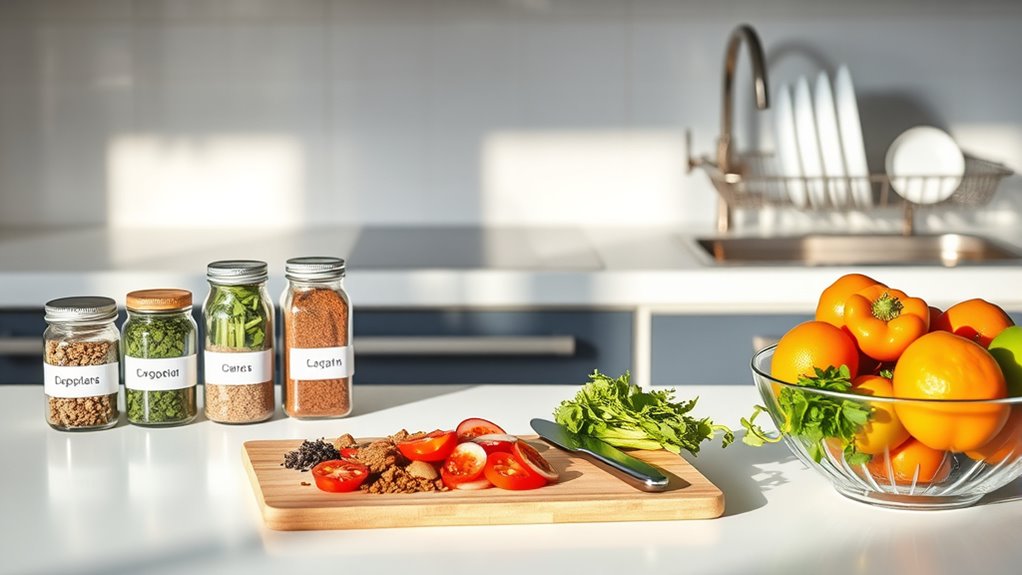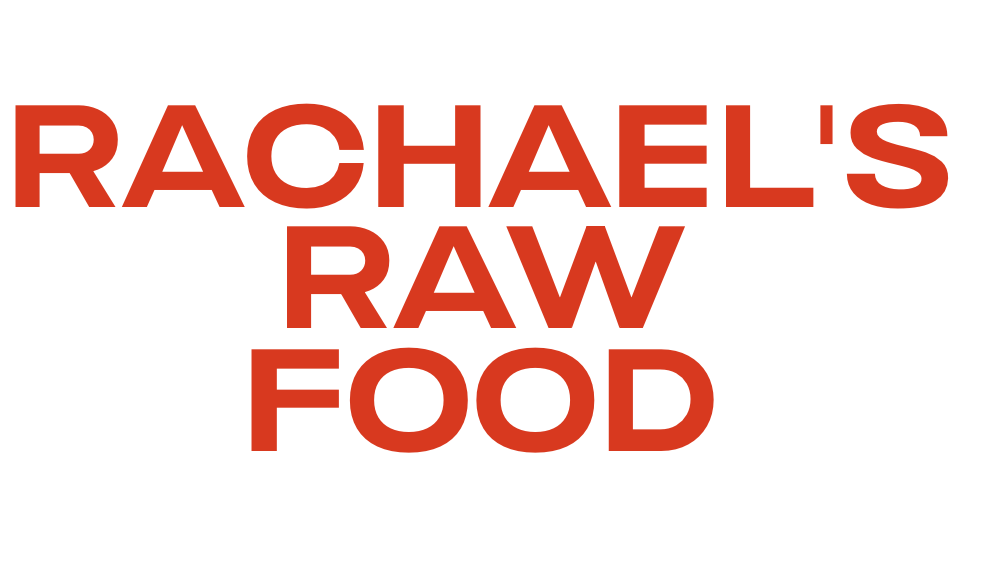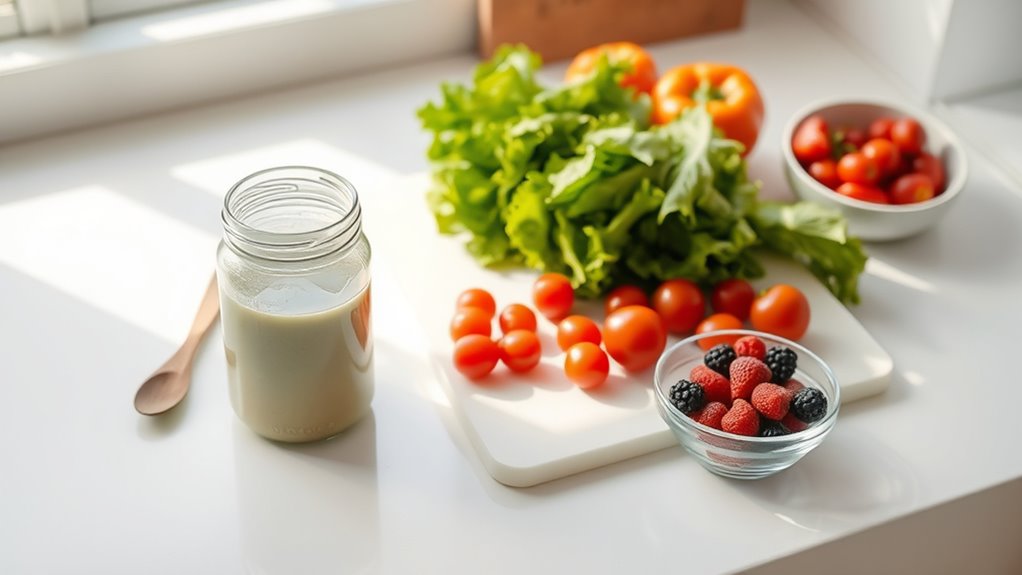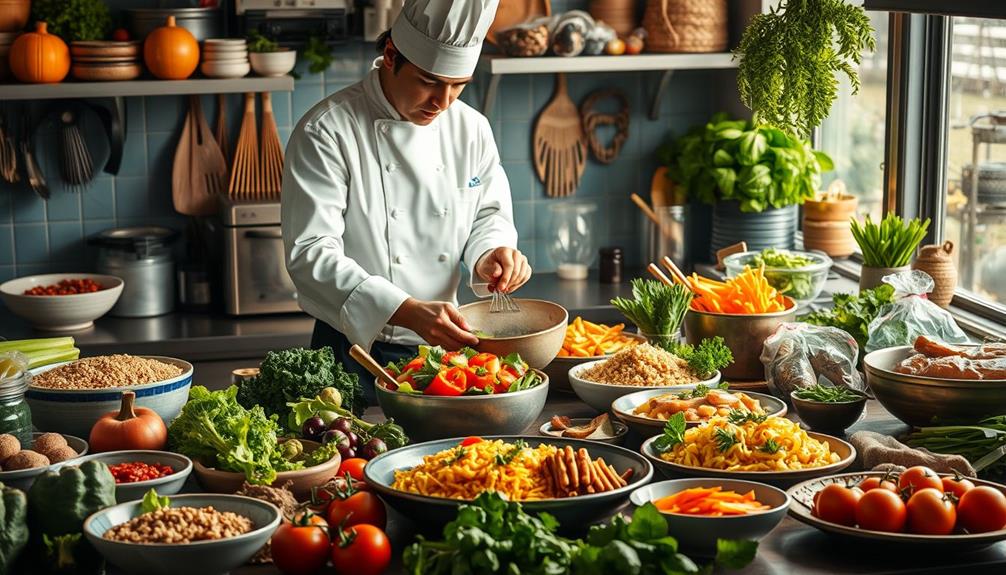In a no-cook kitchen, you must prioritize hygiene by washing your hands thoroughly with soap and warm water for at least 20 seconds before handling food. Keep utensils, cutting boards, and tools clean, and store them properly to prevent cross-contamination. Always separate raw and ready-to-eat foods, and store everything at correct temperatures. Good storage and regular surface disinfection help guarantee safety. Continuing will reveal essential tips to keep your kitchen spotless and safe.
Key Takeaways
- Wash hands thoroughly with soap and water for at least 20 seconds before handling food.
- Use separate, sanitized utensils and storage containers for raw and ready-to-eat foods.
- Store foods at proper temperatures and keep raw and cooked items separate to prevent cross-contamination.
- Regularly disinfect countertops and surfaces, and wipe down utensils and equipment after use.
- Keep handwashing stations accessible, stocked, and encourage proper hygiene practices throughout food prep.

Even without cooking, maintaining food safety is essential to prevent foodborne illnesses. In a no-cook kitchen, where raw ingredients like fruits, vegetables, dairy, and pre-cooked items are common, it’s crucial to follow strict hygiene practices. One of the most important steps you can take is adhering to proper handwashing protocols. You should wash your hands thoroughly with soap and warm water for at least 20 seconds before handling any food, after touching raw produce, after using the bathroom, or any time your hands become contaminated. Proper hand hygiene reduces the risk of transferring bacteria, viruses, or other pathogens onto your food or surfaces. Keep handwashing stations accessible and stocked with soap, clean towels, or paper towels to make this process quick and effective.
In addition to hand hygiene, proper utensil storage plays a vital role in maintaining food safety. You need to keep utensils, cutting boards, and tools clean and properly stored to prevent cross-contamination. Use separate utensils for raw ingredients and ready-to-eat foods, and avoid using the same cutting board for produce and meats unless thoroughly sanitized in between. Store utensils in clean containers or drawers, ensuring they are dry and free from dust or debris. When not in use, cover or store utensils in designated areas to prevent exposure to pests or airborne contaminants. Regularly sanitize utensils with appropriate cleaning solutions, especially after preparing raw produce or dairy products.
Cross-contamination is one of the biggest risks in a no-cook environment, so you must be vigilant. Always wash produce thoroughly under running water before eating or storing it. Use separate storage containers for different food groups to avoid accidental mixing. For example, keep fruits and vegetables separate from dairy or pre-cooked meats. Be mindful of how you handle packaging; avoid touching the inside of containers or the parts that contact the food directly. When storing foods, ensure they’re kept at the proper temperatures and protected from contamination by sealing containers tightly and placing them in clean, designated areas. Incorporating proper storage practices can significantly reduce the risk of bacteria transfer and ensure the longevity of your foods.
Finally, maintaining overall cleanliness in your workspace helps prevent cross-contamination and keeps your kitchen safe. Wipe down countertops and surfaces regularly with disinfectant, especially after preparing different types of food. Dispose of waste promptly and keep trash bins covered. By following strict hygiene protocols, practicing proper utensil storage, and being mindful of cross-contamination, you create a safe environment where food remains fresh and safe to eat—even without cooking. Your diligence in these areas ensures you reduce health risks and enjoy the convenience of a no-cook kitchen without compromising safety.
Frequently Asked Questions
How Can I Prevent Cross-Contamination Without Cooking?
To prevent bacteria transfer without cooking, you should focus on surface cleaning and proper hygiene. Always wash your hands thoroughly before handling food. Use separate cutting boards and utensils for raw and ready-to-eat items. Regularly disinfect countertops and surfaces to eliminate bacteria. Store foods properly in sealed containers and avoid cross-contact. These steps help you keep your kitchen safe and prevent bacteria from spreading, even without cooking.
What Are the Best No-Cook Food Storage Methods?
Imagine your kitchen turning into a fortress against spoilage! Use refrigeration techniques to keep perishables at safe temperatures, and store everything in airtight containers to prevent leaks and odors. Keep raw foods separate from ready-to-eat items, and label containers clearly. These methods guarantee your no-cook foods stay fresh, safe, and uncontaminated, giving you peace of mind and a kitchen that’s a true stronghold of food safety.
How Do I Sanitize Utensils in a No-Cook Setup?
To sanitize utensils in a no-cook setup, first wash them thoroughly with dish soap and warm water to remove visible debris. Then, spray them with a sanitizer spray, ensuring all surfaces are covered. Let the sanitizer sit for the recommended contact time before drying with a clean towel or air drying. This process helps eliminate germs and keeps your utensils safe for use.
Are There Specific Hygiene Tips for No-Cook Meal Prep?
Think of your kitchen as a battlefield, where cleanliness wins the war. You should always practice good hand hygiene, washing thoroughly before handling ingredients. Keep surfaces clean by wiping them down regularly with disinfectant, especially after touching raw ingredients or utensils. Use separate cutting boards for different foods to prevent cross-contamination. Staying vigilant with these hygiene tips helps guarantee your no-cook meal prep remains safe and delicious.
What Are Common No-Cook Food Safety Mistakes?
You often make mistakes like neglecting proper food labeling, which can cause confusion about freshness or ingredients. Poor kitchen organization leads to cross-contamination, especially if raw ingredients are stored near ready-to-eat items. Always wash your hands thoroughly, keep to a clean workspace, and label prepped foods accurately. Staying organized and attentive helps prevent these common no-cook food safety mistakes, ensuring your meals remain safe and delicious.
Conclusion
In a no-cook kitchen, maintaining food safety is vital. Did you know that cross-contamination causes 1 in 4 foodborne illnesses? By practicing proper hygiene, storing food correctly, and avoiding cross-contact, you can greatly reduce this risk. Stay vigilant with handwashing and separate raw and cooked items. Remember, a safe kitchen isn’t just about convenience—it’s about protecting yourself and loved ones from harmful bacteria. Keep these tips in mind and enjoy your meals worry-free.










